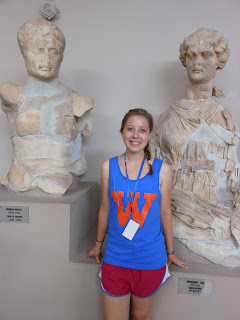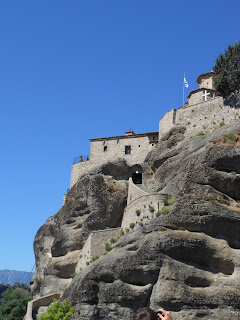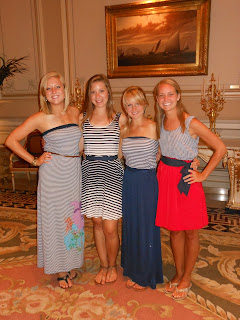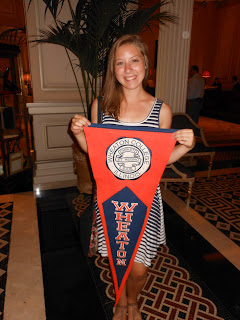Over the last few days we finished our tour of Jerusalem and branched out into Benjamin and the Judean Wilderness.There was so much to see.I am going to try to highlight the places that had the most significance to me.On Wednesday we went to the Church of the Holy Sepulcher—the traditional site where Jesus was crucified and buried. The following pictures are from that visit.
The first one is from inside the tomb. This is a replica, and beneath the stone slab
about five feet down is the original tomb found there by Helena.

The second is a beautiful window I saw high up in the
church. The church is rather dark and
this window with the cross brought streams of sunlight down into the church. I imagine Christ’s resurrection like this—a bright
light of hope and life shining into the darkness of grief and death. Just last night (Saturday night) a small
group of us were locked into the Church of the Holy Sepulchre from 9:00 p.m. to
12:30 p.m. and had a private tour with Father Samuel, an Armenian Orthodox
priest. After my first visit to this church
on Wednesday with all the tourism, I anticipated this tour as it provided a
more worshipful environment. In the
first hour of our visit, we were able to dialogue with Father Samuel and ask
him questions about the faith and practices of the Armenian Orthodox Church. Having done some reading about the Orthodox
faith prior to this visit, I was excited about this opportunity to interact in
person with a father of that institution.
We covered a wide range of topics from Jesus’ humanity and divinity, to
the unity of the Church, to salvation, to the Eucharist, to the role of knowledge
versus experience in one’s seeking after God, to the dynamics among the
Catholic Church, Greek Orthodox Church, and Armenian Orthodox Church in sharing
the space of the Church of the Holy Sepulcher.
From this conversation I was both encouraged and saddened at the state
of division in the one Church. I was
encouraged because Father Samuel was affirming of the salvation and baptisms of
other churches and because his openness to the sharing of the Eucharist among
institutions, but I was saddened by the disputes that arise among the three
churches in the Church of the Holy Sepulcher over the number of candles,
pillars, and altars each one is allowed to have. It was huge privilege to have Father Samuel
go around showing us all the different rooms and altars and tell us their significance
and meaning. Though an amazing
experience, I was glad to leave a little after midnight because the scent of
oil from the lamps and the incense did a number on my senses leaving me with
quite the headache and nausea, but the visit was well worth it.
Back tracking to Wednesday, the next picture is from the
first century southern steps of the Temple.
On these steps Mary, Joseph, Jesus, all his disciples, Paul, and many
other Bible characters would have gone up to worship. With very little left in Jerusalem from the
first century, this was special place of connection to the biblical narrative.

In Luke 19: 41-44 is says, “As he approached Jerusalem and
saw the city, he wept over it and said, “If you, even you, had only known on
this day what would bring you peace—but now it is hidden from your eyes. The days will come upon you when your enemies
will build an embankment against you and encircle you and hem you in on every
side. They will dash you to the ground,
you and the children within your walls.
They will not leave one stone on another, because you did not recognize the
time of God’s coming to you.” On
Thursday we visited the Dominus Flavit, the church located on the Mount of
Olives which stands in remembrance Jesus’ weeping over Jerusalem. It is pictured below with the window looking
out over the Temple Mount.
We visited the ruins of the Herodian Temple on Wednesday,
and in the picture, behind the four of us girls, sit blocks from the Temple
buildings that the Romans destroyed in AD 70.
The verses above came to life in seeing the physical evidence of Jesus’
prophesy.
This next picture is of a first century tomb with the roof
removed.
Below is a view of Jerusalem from the Mount of Olives.
This is a photo from the garden of Gethsemane on the Mount
of Olives.
On Friday, we traveled to the Judean Wilderness. This was my favorite place so far. I could not decide which picture to post of the
Wilderness, because not one could capture its vastness and its beauty. After struggling to see past all the relics
and regalia that fill Jerusalem’s sites, the Wilderness was a breath of fresh
air. For the first time, I was seeing
part of Israel that has not changed since the first century. I cannot go into all the thoughts I had while
sitting there, but I would like to share two.
First, after struggling to stay upright while descending the steep and
rocky slopes of the mountains, I have a greater appreciation for Psalm 37 in
its description of God keeping David’s foot from slipping. Second, God provided for Israel and Jesus
when they were in their different wildernesses, and if God could sustain them
there, I know he can provide for me. It
was a sobering reminder that my worries are so much smaller than the need for
life-giving water and food that anyone in the Wilderness faced.
The last photos are from Gezer in Benjamin. This beautiful and fertile land was a wedding
gift from Pharaoh to Solomon when he gave his daughter in marriage to
Solomon. Pictured below is the
six-chambered gate at Gezer dating back to the Solomonic period. This was a site I remember learning about in
OT Archaeology, so I was really excited to actually see it and walk through the
ruins.
I know this has been a very long post, but we were without
internet for a bit here at JUC. I cannot
believe that I have already been here in Israel for a week. Time is moving quickly, but our days are
packed. I am very thankful for this, for,
though it is tiring, I will not feel like I wasted precious time here that
could have been spent seeing other sites.
Thank you again for all your support and prayers. I have seen them answered in our group’s
continual protection from danger.





















































